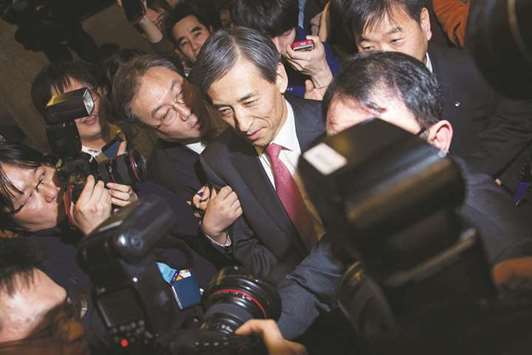South Korea’s central bank kept interest rates steady yesterday, taking an unusually bullish view of economic growth prospects as a new administration formulates multi-billion-dollar fiscal stimulus measures.
The Bank of Korea’s monetary policy committee held its base rate steady at 1.25% as predicted by all 19 economists surveyed by Reuters.
Governor Lee Ju-yeol said the bank was inclined to revise up its growth outlook in coming months from the current 2.6%, a stronger growth trajectory than it had proposed in April.
“It is likely that we will upgrade this year’s economic growth forecast in July,” Lee told a news conference.
“Given robust exports, economic recovery, and the government’s employment-oriented policy stance, wage growth is expected to accelerate in the second half,” he added.
The BoK’s base rate has been on hold at a record low 1.25% since a 25 basis point cut in June 2016.
The bank raised its growth outlook in April for this year to 2.6% from 2.5% estimated earlier.
Lee’s bullish view on the economy pushed up both the South Korean won and share prices.
The currency was up 0.9% at 1,116.7 per dollar while the KOSPI share index extended its gains to an intraday record of 2,342.14 at midday. Lee said he agreed with the incoming finance minister’s view that fiscal policy would promote growth better than monetary policy, endorsing the new administration’s planned supplementary budget to aid job creation.
During his election campaign President Moon Jae-in pledged a 10tn South Korean won ($8.95bn) extra budget before the end of the year, to sit on top of a 400.5tn won budget for 2017 approved by parliament last year.
Market expectations for monetary policy easing have waned as exports surged for a sixth straight month through April, with inflation hovering near the central bank’s target of 2%. “The BoK will stay on hold through the first quarter of next year,” said Kim Jina, fixed-income analyst at IBK Securities.
“The next policy direction will be a hike, but the bank will keep its policy easy to support growth this year and monitor the pace of interest rate tightening by the US Federal Reserve,” Kim said.
Figures out this week showed household debt soared 11.1% in the March quarter from a year earlier, giving the central bank little inclination to set rates any lower and encourage yet more borrowing.
Lee said he saw household debt growth slowing in future, but added “it’s still too early to tell if debt growth has turned around”.

Bank of Korea governor Lee Ju-yeol speaks to the media in Seoul. Lee said he agreed with the incoming finance minister’s view that fiscal policy would promote growth better than monetary policy, endorsing the new administration’s planned supplementary budget to aid job creation.


